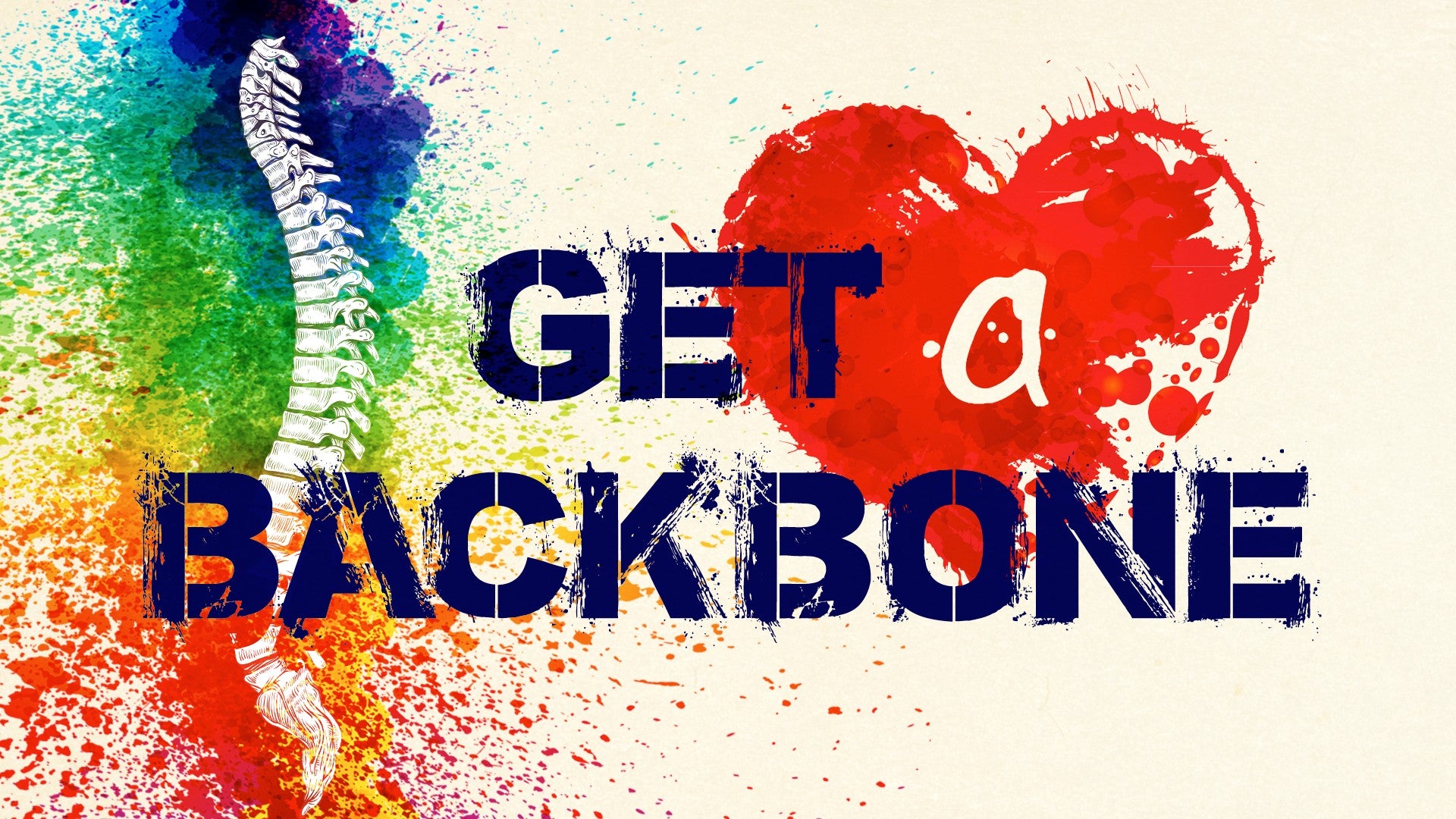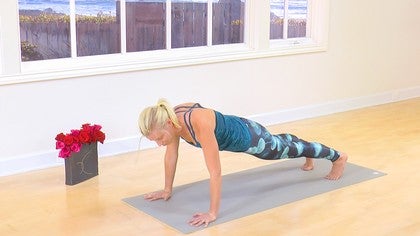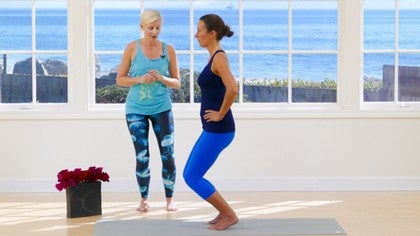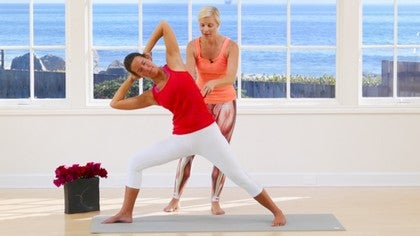Description
About This Video
Transcript
Read Full Transcript
Hey y'all I'm glad you're here. So I'd like to have a little discussion today about plank pose and I'm gonna talk about a couple of things that you might not use in every plank that you do but I'm just trying to give you a way to do a safe plank and build upper body strength in a safe way but also maybe start to find the whole body working together. So you're using your spine in your plank you're also maybe even using the legs the arches of the feet and feeling like the whole body as an organism is working together. Ideally in plank I think it's great if you can feel as if your shoulders are along for the ride that's what one of my teachers said says so it's not like you're just shouldering your way through it it's it's not achy in the shoulders when you get down but instead you feel like the whole body's working together. So before we start I want to give you a little reference to one muscle in the body that might help you it's called the serratus anterior and so it attaches goes underneath the shoulder blade comes underneath the shoulder blade and around the front of the body and then attaches to the ribs. So there's a book called the new rules of posture by a Raufer named Mary Bond and I use her book a lot as a reference for some of the postural techniques I teach and it's a great book definitely recommend it. So in her book Mary Bond talks about how the serratus anterior could give the shoulder its three-dimensional quality and I really like this concept it's basically that you're starting to anchor the shoulder joint into the trunk of the body or into the core of the body although I think the core is often some overused but if you think of the core of the body like an apple core you know think of it from the back the front all around and we're trying to anchor the shoulder joint into that core. So a way to simply feel this might be you can try this is so again we're looking for the muscle that kind of wraps around here goes underneath the shoulder blade and wraps around here it draws the shoulder blades down and into the body. So bring your hands together in prayer position and draw your shoulder blades down your back a little bit you can be in a comfortable position wherever you choose and as you draw your shoulder blades down your back it's almost like if you relax your elbows and press gently into your palms without freaking out in your neck because some people are like you know don't do that just press gently into your palms drop your elbows down draw your shoulder blades down the back and see if you can feel a sensation of some muscular strength starting to turn on kind of underneath the armpits is where I usually cue it. So if you can feel that there then you would just start to take your arms forward and hopefully you can still kind of keep this sensation. So a way to feel that sensation here so we're we're in the upper body plank position you drop your upper arm bones down a little bit shoulder blades down and you feel this sensation maybe of the upper arm bones being rooted into the trunk of the body. So you can also think about the triceps which are the muscles at the back of the arm opposite the biceps so triceps here think of the triceps as if they're connected or bungee corded to the rib cage so you have that connection of triceps to rib cage and I'll refer to that later. So now let's take it on to all fours so you come on to an all fours position and we'll just start here and usually when people come into an all fours position and I do this a lot too this is kind of just a natural all fours position but my upper arm bones are kind of slightly forward and my shoulder blades are up a little bit further than I'd like them to be. So let's draw the upper arm bones back or think about drawing the triceps towards the back of your mat and so that just gives you this. In other words this might be your relaxed tabletop your spine might be long you're engaged but let's just draw the upper arm bones back and some of you might now see feel that serratus muscle kick in again. Get kind of pushed down through your hands and feel the breadth of your back it's almost like a big you know spinnaker sale unfurling as you push down through the hands and feel the breadth of the back. Relax the head and the neck you should be able to move your head and your neck and be relaxed in the face and then the jaw just pressing down through the hands probably possibly drawing the upper arm bones back feeling the serratus anterior. Another cue that helps sometimes is triceps towards the rib cage. So I already feel like I'm really working here and I haven't really I haven't done anything I haven't even lifted the knees yet. So you can relax for a moment kind of shake it out and then let's just come into it one leg at a time. So come back to all fours draw the upper arm bones slightly back crown of the head reaches forward and then we're just going to extend one leg back so maybe I'm gonna do my right leg you extend your right leg back your left knee is still down kind of reach back through your right heel and just pull yourself in opposition so pull yourself long pull yourself taught like a clothesline through the crown of the head. Feel find those serratus get your hands in the place find the serratus muscles by drawing the upper arm bones slightly back and don't do this aggressively like don't freak out and then just try to bring the left leg to meet the right leg. So this is hard I'm working a way to do this so that you're really safe is to maybe lift the hips up and take a little pressure off the shoulders. I know this looks a little sloppy but I never get mad at my students for doing this when they're building their strength. I'd much rather you be here and build strength than here this is like kind of an up dog kind of a plank some people are here they're just like I hate plank but you could get up here and be a little bit stronger or even up here and feel a little sturdier. So you're almost in down dog but you're building the upper body strength. Alright so let's take a little break for a moment and we're just gonna try one more thing sometimes a nice long child's pose with the arms out stretches the armpits here or other people maybe like to bring the arms back beside the body with the palms up this can be hard on the wrist so if you need to strengthen the wrist or you've got problems with the wrist I can I do this work a lot of times by making fists with the hands and bringing my knuckles down so the wrist isn't in extension the wrist is now just in a really nice neutral position which is nice for the wrists it's a good way to do it you could also do it with dumbbells but this is a good way to do it if you don't have dumbbells. Alright so we're gonna come back into another plank this time let's come into it though from a downward facing dog so we're gonna tuck the toes and if you want to pause for a moment when you tuck your toes and then just lift your knees barely off the mat so you lift your knees like a smidge and you'll really feel how the this this is work it almost feels like a handstand that same sort of pressure of handstand try to draw the upper arm bones back and more advanced students you might even try the slightest little cat and cow here just a really teeny little movement with the pelvis try not to move the shoulders or the arms so try to keep that serratus anterior engaged as you move the pelvis so you're you're compromising the pelvis and moving it and trying to keep the shoulder stable you can take a rest if you need to or lift a down dog give a little pedal to the feet relax the head and the neck because whether we like it or not these poses oftentimes bring tension into the face and the jaw so always give yourself a chance to relax all that to release it always give yourself the movement you're craving alright so we're gonna come into plank from down dog so as you shift yourself forward you want to think of your upper arm bones moving back so that's the same sort of what I'm trying to get you to do is find the serratus muscle so the upper arm bones feel as if they're moving back as the torso comes forward another cue I give students sometimes and you can see it from down dog is imagine that your upper arm bones aren't moving as you come forward so you almost try to keep the upper arm bones really still of course they're gonna move and they're gonna shift a little bit but you kind of try to keep them still see if you can find that tricep to rib connection so this is tricep to rib cage so finding your tricep to rib connection just a gentle pulling back trying to fire up that serratus muscle serratus connects into the external obliques so you can find those side muscles of the abdominals and then pick your belly up into your spine pick your front ribs up into your spine gently reach back to the heels pull forward through the toes fire up the front of the body by pulling forward through the toes and then let's lift and get out of there we'll do one more so a little pedal the feet if your wrists are tired you can take little stretches for the wrists just turning the palm in the opposite direction so this last one and I teach in some of my other series a lot of work with the arches of the feet I really have started to see the arches of the feet as such a important part of all the work that we do so we're gonna try to incorporate the legs and the arches of the feet in this last plank so see if you can feel as if your heels are bungee corded to the floor I really like this image so your heels are bungee corded to the floor and the reason I say that y'all is I'll show you most students come forward and they push off the balls of the feet I see this all the time they almost push themselves up and over into a plank and what they do there's no way to get the serratus they push themselves up and over the serratus in a way and they're really far forward or maybe they're back here but they're miserable I'm miserable here I have no connection to my belly I'm I'm sagging it sucks well so let's come into it a little slower think of like the way a turtle comes out of its shell with caution so heels bungee corded to the floor and just pull back through the heels as the torso comes forward remember the upper arm bones kind of pull back gently it's kind of like you're unfurling yourself and then you pull yourself taught like a clothesline again I'd rather you have your hips up a little bit so maybe here then down low sagging so use your lower belly to keep your pelvis up pull the front ribs up into the body maybe even soften the knees a little bit find the arches of the feet so arches of the feet are like it's like a rocket ship you can feel the fire coming out of the arches of the feet and then crown of the head reaches forward and slowly lower the knees down that's a lot and relax so just take a couple of breaths and then you might roll your forehead in towards your knees come up and just a nice quick stretch of the wrists if you want to give your wrist a little stretch you could do this by bringing the backs of the hands together or sometimes I even do the chicken wings you know bring the hands underneath and you can also do things like kind of rolling the wrist or even just simply shaking them out so I hope that helped maybe gives you some thoughts things to ponder food for thought on your plank thanks so much namaste
Get a Backbone
Comments
You need to be a subscriber to post a comment.
Please Log In or Create an Account to start your free trial.

















